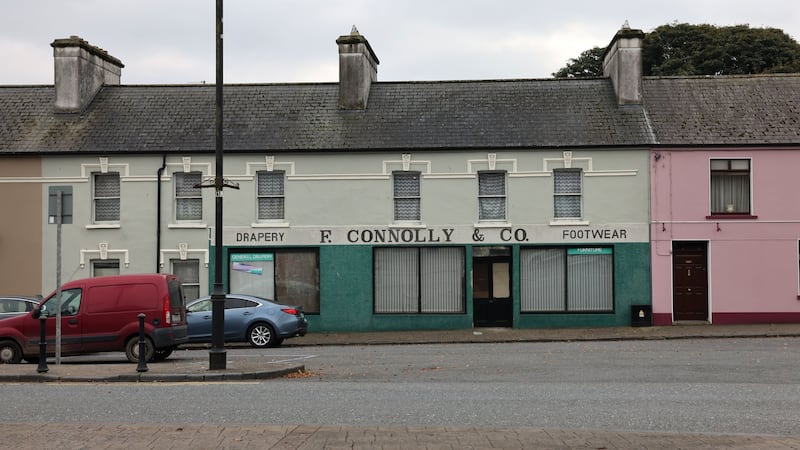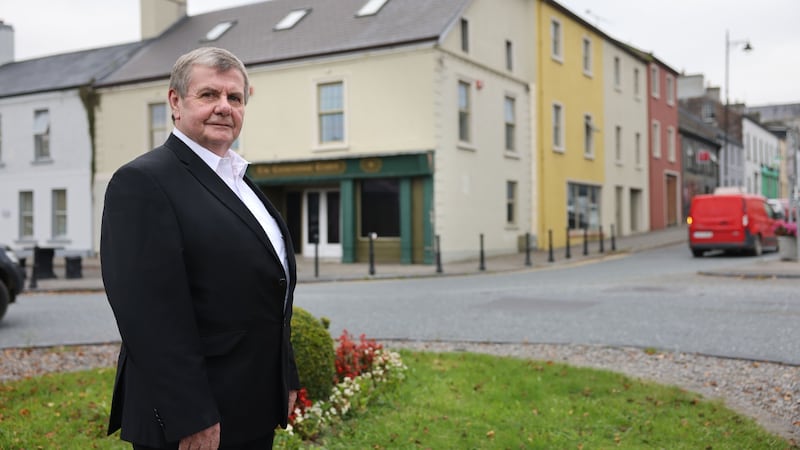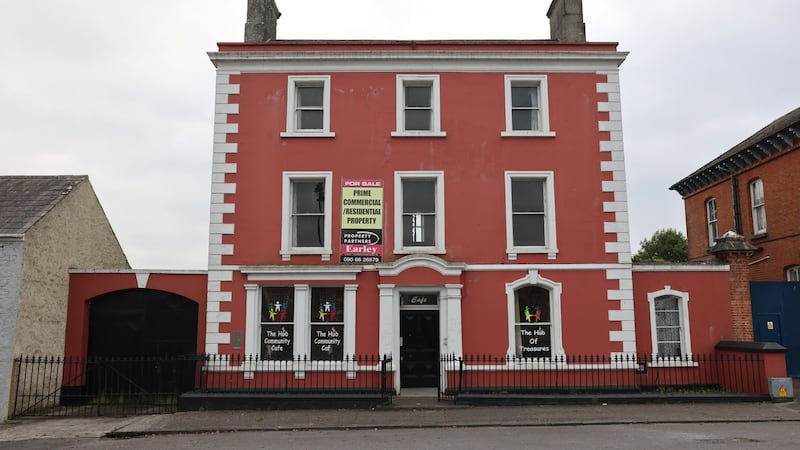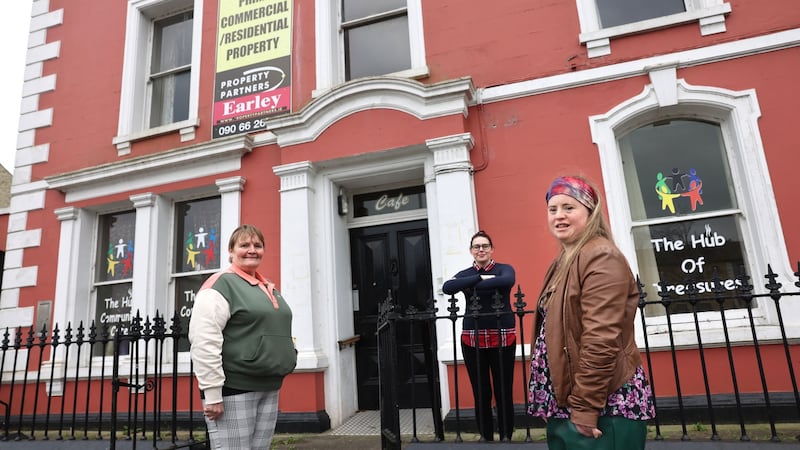The wet weather reflected the town's mood. Everything felt grey on an overcast Friday in Strokestown. Drizzle coated customers as they banked for the last time in the Roscommon town.
The Bank of Ireland branch, previously an old National Bank outlet, dates back to when Gladstone was British prime minister. A shift to internet banking has meant this old market town – a busy crossroads near the centre of Ireland – is without a bank for the first time in more than 150 years. It was one of 88 branches – a third of Bank of Ireland's network – to close a week ago.
People used to come in to sell their calves and pigs and eggs and turkeys every Friday, but it is a different world now
“It is the end of the town as we knew it,” says Mary Fallon, emerging from the bank for the last time and wondering how she will bank now. “If you are the same age as I am and you don’t drive a car, what can you do? I will depend on my neighbours to get into Roscommon or Longford. It seems very sad that they can just pull out.”
The 80-year-old was born down the street and remembers when there were two banks in the town, with the managers living above them.
The buildings behind Fallon are architectural evidence of Strokestown's decline. Next to Bank of Ireland is the three-storey National Irish Bank, which closed 20 years ago. It was, until the summer, home to The Hub Community Cafe and The Hub of Treasures, a shop run by the Brothers of Charity. Now there are weeds out front and a "For Sale" sign above the door.
To the left is the old Market House with the obsolete weighbridge out front, the administrative hub for what was once a bustling weekly market that filled the broad avenue of Church Street. Today, there are just four stalls, selling vegetables, plastic containers and various clothing.
“People used to come in to sell their calves and pigs and eggs and turkeys every Friday, but it is a different world now,” says Fallon.
Her friend Sunniva Sheehan, a retired pharmacist, remembers the market well. “It would take us all day to come home from school on a Friday evening because you would be looking at the turkeys and the chickens,” she says.
It is like a scene from a western film; you have grand fronts but nothing behind them
Locals estimate that more than a third of the buildings along Church Street and the adjoining Bawn Street running down the centre of the town are vacant. Empty and derelict buildings have been given a recent facelift of paint but this just masks the decay.
“It is like a scene from a western film; you have grand fronts but nothing behind them,” says Sheehan.
Vacancy rates in Roscommon are among the highest in the country, with its towns plagued by dereliction. Just over 17 per cent of the county's commercial buildings were vacant in June – the second highest vacancy rate in the country after Sligo – and 12 per cent of its residential buildings were vacant, second only to Mayo, according to GeoDirectory, the company run by An Post and Ordnance Survey of Ireland. Connacht has the highest vacancy rates of any province.
Locals see the economic strength of the country disproportionately leaning towards Dublin and the east.
“There are two Irelands. You could draw a line down the middle of Ireland. You are on the wrong side of the line here,” says Shane Lynskey, a local solicitor and chairman of the Strokestown Town Team, a group of residents trying to sustain and restore the town.
“To hell or to Connacht,” adds vice-chairman Jonathan Cassidy.
As locals see it, Strokestown, one of the country’s few planned towns, needs a new plan to prevent it turning into a ghost town like others nearby.
Lynskey and Cassidy point out the buildings abandoned over the years, the pubs sold and the proposed property developments of the Celtic Tiger that came to nothing, despite the grand plans and hefty bank loans that briefly supported them.
Land Registry records and Roscommon County Council planning files – along with the accounts of locals, owners and one-time occupiers of the properties – tell the stories behind three vacant buildings that chart Strokestown's recent history.

Connolly’s Drapery
A sticker on the door helps date the shop. Surrounded by the listed green mosaic shopfront, the sign says Connolly’s was an agent for B&I ferries, a brand last seen in the 1990s.
Jonathan Cassidy remembers buying his first pair of Power football boots in the shop as a boy three decades ago. He recalls the shop’s two female shopkeepers competing for your business as you walked in. “It was like Are You Being Served?,” he says, mimicking a character from the old British sitcom.
Lynskey has photographs of the shop’s last day and the three-generation family business locking the door for the last time more than a decade ago.
“It was poignant, the end of an era,” he says.
Strokestown was, at one time, home to three department stores; now there are none. People travel to nearby Longford, 20 minutes away by car, to shop, drawn by supermarkets such as Tesco, Lidl and Aldi.
“They have sucked away the commercial activity from Strokestown. People are more mobile now,” says Lynskey.
At the peak of the economic boom, two Leitrim property developers, Paul Keaveney and Dominic Holohan, announced plans to redevelop Connolly’s and the adjoining corner-shop premises with borrowings from BoI. But the property market turned. By the end of 2009, their company, Celtic Property Projects, had €640,000 in debts and was nursing losses of €144,000.
A letter to a council planning enforcement officer the following year reveals the pressure they were under. Keaveney requested a compromise on the planning permission to build a new shopfront promised to a prospective buyer. A bank loan for the development had put the company in “an even more precarious” position, he wrote, and if they didn’t build the shopfront, the buyer would pull out and the bank would repossess.
That happened four years later: the bank put in a receiver, who valued the property at just €90,000.
They will know that they are as well to throw their money into the river as come into Strokestown for big retail
Estate agent Kieran Leavy, the current owner of the building, says the two developers thought they were going to get shop units “all around here. It was never going to happen, even in the Celtic Tiger times.”
Leavy’s office sits on the corner where the developers once envisioned a shop. He has plans to redevelop the property into an office, a barber shop and a flower shop with a charity as a potential tenant. He thinks that, post-pandemic, Strokestown will become “a satellite residential town” with remote workers, a place to live and commute to Dublin a few days a week.
Such is the demand from people relocating that he recently sold 15 homes in just two weeks.
The first thing prospective buyers looking to work from home ask about is the broadband speed. “Broadband is a necessity,” says Amanda McDermott, sitting at a desk opposite Leavy.
Leavy says Strokestown needs a good coffee shop and could benefit from more tourists coming into the town when they visit the National Famine Museum in Strokestown Park House, which is owned by the Callery family’s Westward Scania motor business. Access is an issue; the entrance gate from the house into the town is narrow, preventing tour buses entering and leaving the grounds.
Other than a cafe, Leavy sees no other retail businesses moving into Strokestown. He says the loss of the Bank of Ireland branch will add hours of commuting time to his working week to travel to banks in nearby towns and will guarantee that no other businesses will come here.
“There is no retail going to come into Strokestown because you don’t have the population to support it and anybody that’s of any substance will have their market research done,” he says. “They will know that they are as well to throw their money into the river as come into Strokestown for big retail. The business isn’t there.”

The Cornerstone
On the corner opposite Leavy's office is the old Cornerstone pub. There were once almost 30 pubs in Strokestown. Their number has fallen to single digits, including the bar in the Percy French Hotel.
In 2005, publican John Tully was granted planning permission to demolish part of the Cornerstone and build 21 en suite bedrooms and a larger pub. The property was later bought by a large construction business run by the Cox family, whose ambitions for the area were matched by their company's borrowings.
Jonathan Cassidy recalls one of the developers in the family, Leo Cox, telling a radio interviewer that it was a disgrace to think that in rural Ireland you cannot go into a shop and buy a pair of socks, and that he intended to change that.
The corner property was renovated but the development company run by the family, EDA Cox Construction, fell victim to the property crash. Receivers were appointed and the Strokestown property was repossessed in 2011 by one of the company’s banks.
Today the empty property is owned by local councillor Tom Crosby, who resolved planning difficulties with the building and completed the facade. He has about 1,115sq m of space.
“If you had a good anchor tenant, I have no doubt it would generate the interest that would get other businesses in,” says Crosby, who is from nearby Tarmonbarry.
His own attempt to bring in an anchor tenant came undone because of the closure of the bank branch, he says – even with an offer of two years of free rent, the prospective tenant told Crosby: “We would really need to have a bank present in the town.”
He believes Government incentives similar to the Section 23 tax relief could help small towns attract investment to rejuvenate vacant properties. “Strokestown was a great market town and I am quite confident that it has the surrounding population that could bring it back to its glory days,” he says.
He believes the new €200 million bypass on the main N5 Roscommon road, approved by the Government in June, will inject new urgency into the town’s rejuvenation efforts. “There is a great energy there to bring Strokestown back to the town it was.”

The Hub
Sarah Flynn loved working in the Brothers of Charity shop in the old National Irish Bank branch on Church Street. She enjoyed chatting to customers, helping them find their size in clothes and giving advice on jewellery and scarves.
“Working in the charity shop was a happy time for me,” she says. Customers regularly stopped in to shop or have a cup of coffee in The Hub cafe in the building after dropping into the Bank of Ireland next door.
Locals described the cash machine at the bank as one of the busiest ATMs in the country. It was the first ATM that motorists could pull up outside after leaving Dublin on the road to Westport and Castlebar. Even on the day the branch closed last week, there were queues to withdraw cash.
The bank says it considered the use of ATMs as part of its decision-making on branch closures. But footfall at the shuttered branches had dropped 60 per cent over recent years while digital usage had increased by a third.
Locals say that the closure disadvantages older people who struggle with online and mobile banking. And the loss of passing bank customers means a loss of trade for other businesses.
“It was extremely helpful to have that size of a building and to have it beside the bank because people going into the bank called into us,” says Audrey Murphy, team lead for day services at the Brothers of Charity. Now the two former banks are empty and the charity has relocated elsewhere in the town.

“It was like a second home to a lot of people,” says Patricia Carolan. who worked in The Hub. “It is a shame we have lost it because it meant a lot to everyone.”
Longford-based solicitor Michael Butler bought the three-storey building two years after National Irish Bank closed the branch in 2000. It had been a bank for more than 100 years. He used the building as an office for a time before leasing it to the Brothers of Charity.
“It now leaves a three-storey gaping hole in the town,” says Cassidy, standing outside the building. “That could be a fabulous restaurant. That is missing from the area.”
Estate agent John Earley who is selling the property, says he has a buyer for the building and that the sale should be finalised soon to a local man who plans to leave the ground floor as commercial space and live in the top two floors, like the bank managers of old.
Earley sees a future for this building and other commercial premises in the town as refurbished residential properties. Increasingly he believes people in Dublin see value in larger properties in cheaper locations.
“A lot of those small shops are all going to die out because there is no commercial life for them, but luckily there is residential demand to take them. That is going to enhance villages,” he says.
“Sadly, a lot of these towns, it is like someone turned out the light and nobody looked back for 10 years.”
In this month’s budget, the Government set aside €50 million for the new Croí Cónaithe – Living Heart – fund, part of which will be used to refurbish existing and vacant properties in town centres and villages. The plan is targeted at vacant properties and will introduce incentives for the rental and sale of vacant properties and the use of compulsory purchase orders for onward sales.
The timing is critical as the pandemic has pushed more people online.
The average size of a house in rural Ireland is 240sq m. It is unnecessarily large. But we are letting people build that
Housing policy analyst Lorcan Sirr, a lecturer at Technological University Dublin, fears more businesses will pull out of towns and force customers to shop online as broadband coverage becomes more widespread. "It is only going to get worse as broadband rolls out," he says.
To address high vacancy rates, he sees a carrot and stick approach to renovating disused properties in rural towns into commercial space downstairs and living space upstairs. The stick is taking away, or reducing, commercial rates tax rebates to push owners to refurbish; the carrot is an improved “one-stop shop” service to expedite planning, fire and disability certifications.
Sirr puts high residential vacancy rates in towns down to the “very generous” practice of local councils granting planning permission for one-off houses around them. Refurbishing existing properties in towns would find a new use for them while reducing environmental costs by avoiding new construction.
“The most sustainable house in the country is the one that already exists,” he says. “The average size of a house in rural Ireland is 240sq m. That is like a Victorian house in Dún Laoghaire [in Dublin]. It is unnecessarily large. But we are letting people build that and have two diesel cars way out in the country and yet we have a town full of empty buildings. Then people wonder why the pubs are closing.”
Audrey Murphy of the Brothers of Charity is optimistic about Strokestown’s future because of the local “town team” and the energetic residents looking to reinvent and improve the town.
“Every building is just bricks,” she says. “It is what we make of our buildings.”















